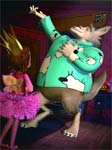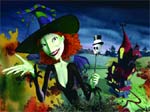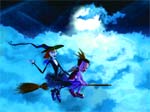VANCOUVER - It's been a year rife with the protean efforts of film studios and visual effects artists struggling to bring the fantasy visions of comic book creators and children's book authors to the screen. Profitably.
Now, with Halloween upon us, comes an eerie tale of an artist who works both in comics and children's books, Jill Thompson, and her attempt to bring her creation, Scary Godmother, to life for the TV screen. Thompson works in watercolors, but if you look at her books and comics, you quickly recognize her reliance on the hyperreal "camera angles" exploited by fantasy comics artists over the years and now employed more and more by filmmakers.

During the production of Scary Godmother, Mainframe's team ballooned to about 50.
|
Thompson wanted to breathe more life into her spooky cast of characters for an animated TV special and DVD but she did not want to have her work simply copied by a distant cadre of cel animators. She wanted her first animated special to convey a strong sense of three dimensions while also maintaining the color palette and cartoon-y style she'd developed over years.
Thanks to the hard work of Mainframe Entertainment (www.mainframe.ca), here, Thompson has it both ways. The new 48-minute Scary Godmother Halloween Spooktakular special, which is airing in late October on YTV in Canada and, via Disney International in Asia, Latin America, Germany and Italy, features the title character and a host of kids and hobgoblins all rendered in 3D and moving convincingly around 3D sets that have received a paint job that looks just like Thompson's own 2D brush strokes. And in some cases, they are.
"We took the look from the watercolor books and Jill was the art director on the show and she did a lot of paintings for us that we used both as matte paintings, which gave us a real good feel for her art style, and used 2D images right within the frame," says Scary director Zeke Norton for Mainframe. "She would paint the sets and we would take the watercolors from those paintings and use them to texture our sets." Norton's team, which burgeoned to about 50 during production, relied heavily on something very new to them - the Softimage|XSI 3D production system. "To further mimic Jill's style," Norton continues, "we used the ToonLine shader within XSI to put hard black lines around all the set elements because Jill starts with a thick black ink line and then fills it in with watercolor. The sets look exactly like she had painted them, although they are 3D."

Mainframe used this Scary project as a test case to work out a Softimage|XSI production pipeline.
|
Mainframe came to prominence in the '90s with Reboot, the first all-3D animated TV series, and has developed credits that include the Spider-Man and Max Steel series, various Barbie specials and even animated segments in the recent MTV Movie Awards.In this new show, 3D characters such as the Scary Godmother herself, who is a hip, likeable witch, look like they're walking right out of the pages of one of Thompson's books.
Editor's Note: IDT Media's animation unit, Digital Production Solutions (DPS) in Newark, NJ, has signed a letter of intent to acquire a controlling interest in Mainframe Entertainment.
Scary Godmother's plot revolves around a little girl whose mean cousin and friends play a nasty Halloween trick that leaves her locked in a haunted house with you-know-who. The title character turns out to be more than accommodating and stages an elaborate revenge on the older trick-or-treaters. The creators' hope is that they've fashioned an enduring Halloween classic and, based on the level of wit and sheer energy on display in the show, they may have succeeded.
MIXING WATER COLORS AND DIGITS
Eager to contribute to the process, Thompson would paint watercolors of important sets such as the Scary Godmother's living room from four different angles, Norton says, and then "using Adobe Photoshop and [freeware called] Gimp, we would grab pieces of the paintings and use that as the basis for our textures."
Thompson was pleasantly shocked by the outcome. One scene depicts a skeleton character and an exterior of the witch's house. "I knew I had never painted that specific scene," says Thompson. "They had sampled texture and color and used it to render the landscape and the house. It was so gratifying and amazing; I had to stop and rewind it several times." Thompson is based in Chicago and during production she received weekly tapes from Vancouver showing advances in the program. She also had access to Scary Godmother work on the Mainframe Web site.
In another scene, Thompson saw her title character take Hannah Marie, the little girl, for a ride on a broomstick through the clouds of the night sky. The clouds take on the form of giant, hungry jack o' lanterns. "It was incredible, amazing. I'd painted a sky. I expected to see Scary Godmother and Hannah flying past the sky with stars that I had painted. Suddenly there were these rolling, beautiful clouds that look like cotton candy when you're in an airplane."
Thompson had seen some early test shots from Mainframe in which her work was rendered with more of a 2D look but, being a fan of stop-motion features such as Tim Burton's Nightmare Before Christmas, she insisted that Scary Godmother's characters look more like 3D or stop-motion puppets. And she knew that "Mainframe could make something that had that quality without having to build everything in reality. The animators were so nice to take all my comments into consideration. It was very true to the books and comics."
Mainframe artists gave Thompson's cast rich portrayals that include deft lipsync to actors' voices. Her characters' sheer variety is borne out in an animated werewolf, complete with fur, a discombobulated skeleton named Skully, a vampire family and more.

Mainframe used XSI's ToonLine shader to mimic the visual style of Thompson's books and comics.
|
AN EVERYTHING BOX
XSI offers a wide array of features beyond the useful ToonLine shader function. Softimage boasts that XSI provides artists with "performance and productivity enhancements across the complete range of modeling, animation, simulation, rendering and compositing toolsets."
XSI's latest release, V.3.5, was designed to create increased efficiencies in large scale production situations such as Mainframe's, and Norton foresees the studio making a move to go all XSI in the near future. "On Scary Godmother, this was very much an experimental process for us," says Norton, who has directed for Mainframe for five years. "We kind of trained on the job." Mainframe used the Scary project, which did not have a hard deadline, as a test case to work out a useful XSI production pipeline. He allows that the system's frequent software upgrades - about 15 in all during the production - sometimes flummoxed his artists but adds that "by the end of the production it was pretty solid. We used what we knew because the animation core was pretty similar to Softimage 3D with a lot of extra bells and whistles, which we started to branch out into. It's an 'everything box' and we are starting to take advantage of it.
"One of the things on Scary Godmother that we really did appreciate was the effects tree compositor," Norton continues. "Normally our lighting and effects department will take care of the tricky compositing for shots with a lot of characters or a lot of elements. We were able to do a lot of that compositing using the XSI effects tree. It's pretty intuitive and the animators picked it up pretty quickly, and they could deal with the bulk of their own shots."
Now Mainframe is training all its animators on XSI. One big benefit is that "an individual animator can take their shot to a higher level of completion and then the next department that would normally get their shot can add on top of that. The end result is that, since people are adding a little bit more than they used to to each shot, by the time it gets out it's maybe twice as good as it used to be in Softimage 3D."

Teamwork: Director Zeke Norton (left) with Scary Godmother creator Jill Thompson.
|
Norton and Scary Godmother line producer Sharan Wood also praise XSI's workflow as "quite a bit faster." XSI's "animation mixer" allowed Norton to make changes in the middle of a shot that was already approved. Being a comedy, Scary Godmother had an unusually large number of shots of longer duration - often :15 compared to the more typical :02 in an action show. "An animator sweats over a :15 shot for a week," Norton says, but with the XSI animation mixer he had the freedom to make subtle changes in the action in the middle of the shot without changing the whole shot. Norton stresses that, especially on a TV production, he would never previously have considered doing such a thing.
The animation mixer also allowed the Mainframe team to go in and out of cycles easily, especially in the show's dance sequence. "And you can blend cycles very easily, so you can walk to run or run to stop," he adds. Animators could easily add a talk action to a character's walk cycle as well.
XSI supported the modeling effort, too. "The polygonal modeling tools in XSI are fantastic, they're very powerful," Norton enthuses. "They're so good that our modeling department switched over to XSI before everybody else. You can build your models very low rez and at the touch of a button the computer figures out how to make high rez versions of it. The trickiest thing in our pipeline for our modelers, the texturing, is completely different; it's philosophically miles different than it was in Softimage, but you get many more options."
Wood says there were originally about 25 animators working on Scary Godmother, and "we did have a core of about 10 people who were there for most of it" who came out of the production as XSI experts able to train new animators on the system. Thanks to Mainframe's size, during the show's eight-month production cycle the Scary team was able to bring in other Mainframe animators who were between projects and put them to work as needed. "The full contingent was about 50 people," Wood says, "including directors, supervisors, animators, modelers and the production team," all relying on about 20 seats of XSI running Linux on a mix of Dell and HP PCs.
Norton says Mainframe will be buying additional XSI systems, which render with Mental Ray, to power new productions.
Norton and Wood grew to depend on XSI as their project progressed. "We've only just scratched the surface of [XSI]," Norton says. "The more stable it gets, the more a fan of the software I am. The end result looks better - it's a better looking show than we could have done in Softimage 3D." Norton is now looking forward to directing his next Mainframe production also created solely within XSI. And Wood says that it was the look they achieved for Scary Godmother that actually brought in the business for a new show to be announced soon.